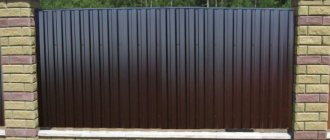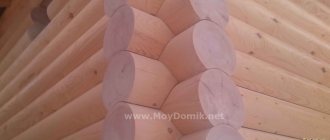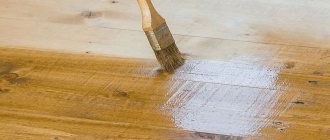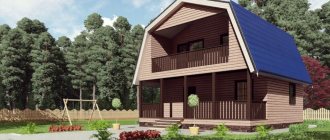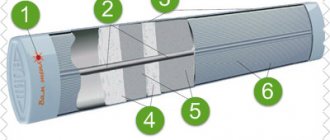When you need a reliable but lightweight budget covering, you most often pay attention to such a fashionable roofing material as ondulin. Light enough, it is well suited both for a summer house and for the roof of a residential building, completely fitting into the design concept of even expensive projects.
But opinions about the durability of the appearance and protective properties of Euro slate today are divided, and for good reason. Therefore, if you are skeptical and surprised by those who choose “cardboard” as a roof, then our article will help you weigh the pros and cons. And also discover new sides of this roofing material, learn about new products and subtleties of the installation process!
So, we propose to take a fresh look at such points: what ondulin is and what its pros and cons actually are, how to find high-quality material and what are the subtleties in the operation of such a roof.
What is ondulin?
Ondulin was created in France (Europe) on. It is usually classified as an environmentally friendly building material of organic origin. This cheap roofing coating is based on ordinary cellulose. But to prevent it from getting wet under precipitation on the roof, the canvas pressed from it is treated with bitumen impregnation.
The composition for laying the roof includes:
- Pulp (paper).
- Mineral filler.
- Bitumen with polymer resins.
- Pigments.
In production, cellulose is pressed into plates 2–3 mm thick and corrugated to create waves of the desired size. Then it is impregnated with a mixture of bitumen and pigment additives. The output is a wavy sheet that looks like slate or metal tiles with a wave-shaped profile.
Sectional view
The technical specifications are as follows:
- Noise insulation – up to 40 dB;
- Thermal resistance – up to +110 C;
- Frost resistance – 25 cycles;
- Weight – 6.5 kg for a standard sheet;
- Breaking mechanical load – 960 kgf/m2;
- Fire safety class – KM5 (flammability G4, flammability VZ).
Table of physical and mechanical characteristics
| Characteristic | Meaning | Note |
| Strength, kPa | >1800 | — |
| Breaking load, kg s/m2 | 960 | The rafters and sheathing are destroyed, but not Ondulin |
| Elastic modulus, kg s/cm2 | Emax - 8.160; Emin — 3,940 | — |
| Thermal conductivity, Kcal/mh°C | 0,19 | Low thermal conductivity compared to design value |
| Thermal resistance, °C | up to 110°С | Properties do not change, shape and elasticity are maintained |
| Noise insulation, dB | 40 | — |
| Frost resistance (thaw cycles) | 25 | The slabs are frost-resistant |
The roofing material in question is resistant to alkalis, petroleum products and acids. It can easily withstand a column of snow of 2.5–3 meters and heavy downpours. Manufacturers claim a guaranteed service life of 15 years, but in fact, ondulin can last up to half a century after being laid on the roof of a cottage or outbuilding. It has excellent water resistance, but frankly poor fire resistance (included in the last highly flammable group of building materials).
Be careful - the material is not fire resistant
When burned, ondulin releases toxic substances and strong smoke. But it can catch fire on roofs from sparks or flying coals only where the flame is able to reach the cellulose - in damaged areas or from the end of the sheet. The surface of the latter is impregnated with fire retardants. It will flare up only if it is heated to 200–230 C.
Production process
The light weight, moisture-proof properties and ease of installation of ondulin are explained by the characteristics of the substances from which it consists. It, like onduvilla, is produced from environmentally friendly, healthy components, which cannot be said about asbestos-cement slate.
The composition includes waste from the pulp industry, petroleum bitumen, polymer resins, natural pigments, and modifiers. During the production process, ondulin coating and onduvilla go through 5 stages:
- The first stage of manufacturing this roofing material is called wet, since during it waste paper, cleared of impurities or debris, is mixed with water, obtaining a wet paper mass called pulp.
- The next phase of production is called drying. During this process, the prepared pulp is fed to a conveyor, where it is given a wavy shape and then dried.
- Completely dried sheets are cut according to standard material sizes, and then sent to the impregnation workshop.
- Sheets of roofing material are impregnated with petroleum bitumen on both sides under high temperature and pressure.
- Onduvillas are stacked on pallets and then wrapped in shrink film to prevent mechanical and weather damage to the material during transportation or storage.
The conveyor for the production of this roofing material produces one finished sheet in 4 seconds. From the moment the pulp is supplied to the conveyor to packaging, ondulin is produced within 45 minutes. During the manufacturing process, all components included in the coating are checked for compliance with safety requirements. Thanks to strict quality control, it is considered one of the most environmentally friendly materials.
Advantages of the material
Material properties
Sheet sizes
All sheets produced in Russia by the ONDUliNE concern have typical standard dimensions of 2000 x 960 mm or 2000 x 760 mm. Their thickness is 3 mm, wave height is 36, and the number of waves is 10 or 8. Other sizes of ondulin roof coverings are not produced in domestic factories. However, in the USA and Europe, some manufacturers make them 1–1.22 meters wide.
Sheet sizes
Standardized sheet sizes simplify roof calculations, installation and material purchases. One person can handle laying flexible slabs with an area of less than two square meters. Their windage and weight are minimal. The waves in all cases also have the same size. You cannot find a better roofing building material for a roof in terms of lightness and ease of installation.
Compound. What is the material made of?
Ondulin is based on several components.
Production technology involves high pressure on raw materials, which ensures high strength of the finished product. Ondulin is produced in several stages. It looks like this:
Cellulose is cleaned of any impurities and contaminants, mixed with water, modifiers and dyes. This substance is called pulp.
The pulp is fed to a special conveyor, where it is compressed into sheets of a given thickness, acquiring a wavy surface.
Then the sheets are treated on both sides with bitumen.
At the final stage, the finished products are stacked, packaged and provided with labels with information about the characteristics and properties of the material.
Advantages and disadvantages
Ondulin for roofing has a lot of advantages, including:
- High water resistance;
- Resistance to fungi;
- Standard sheet sizes from different manufacturers;
- Light weight and easy installation;
- Environmental Safety;
- Variety of color palette;
- Flexibility of sheets (roofs can be covered with the most bizarre shapes);
- Good noise insulation performance;
- Comparative cheapness of the material.
Simple installation of ondulin
To cut ondulin sheets, it is enough to have a hacksaw in your hands. In terms of price, slate is 30–40% cheaper than its bitumen counterpart, but contains harmful asbestos. At the same time, it is comparable in cost to a metal roofing sheet, but is easier to install.
It can even be installed on top of an old roof
Among the disadvantages of ondulin roofing it is worth noting:
- Loss of color due to prolonged exposure to ultraviolet radiation;
- The presence of unpleasant bitumen fumes in extreme heat;
- Quite a high fire hazard.
Often cottage owners mention as a disadvantage that paper-bitumen ondulin is too soft. Roofs with it are supposedly not able to withstand snow or even a person, and it is better to choose a more expensive and durable corrugated metal sheet. But here the question is more about the correct execution of the sheathing. Its pitch under the roof should be less than 0.6 meters, otherwise the covering will definitely bend. Whereas metal roofing can be laid on lathing with a large distance between the slats.
Do the sheathing correctly
Buyer Help - Roofing Calculators
The easiest way is to calculate the number of sheets for a roof with two slopes. But if we are talking about a roof with a complex configuration, it is better to double-check the numbers. To do this, you can use an online calculator developed by specialists. The tool is located on the manufacturer's website:
For maximum accuracy, it is better to have a design of the future roof at hand or at least know its dimensions. In the online form, you must indicate not only the dimensions of the slopes, but also other parameters: slope angle, length of additional elements, presence and number of pipes, need for roof insulation. Material consumption will be calculated automatically.
From the page of each calculator you can go to the pages of other tools. This is convenient if you want to “try on” different colors and types of roofing, estimate the cost of several options and choose the optimal one. Please note that the final price will depend on your location and transportation features. Please contact your local dealer for this information.
Source
Which is better: ondulin or metal tiles?
Comparing 2 materials
When choosing “ondulin or metal tiles”, you need to focus on the capabilities of your wallet, the conditions under which the roof will be used and the shape of the latter. At a price per square meter, taking into account installation costs, such a roof is comparable to a metal tile roof.
The material itself is cheaper than metal tiles. However, the shape of the waves and the size of the sheet are such that there are fewer scraps as a result of cutting. Plus, you will need much more self-tapping screws per square meter of ondulin coating than for corrugated sheeting.
As a result, the cost of the roof in both cases turns out to be approximately the same.
In terms of service life, the profiled sheet wins - 30–50 years versus 10–15. But a lot depends on the quality of the protective coating of the metal tile. The more durable it is, the more expensive the profiled sheet will cost. The situation is similar with fire resistance. A thin profiled sheet, comparable in price to ondulin, burns out as quickly from exposure to open fire as a bitumen-paper coating. A thicker one is a good option and costs more.
Metal tiles differ more significantly from their ondulin competitor in terms of strength. Roofing from the first one better withstands frost, heat and precipitation. But it is easier to cut; any complexly curved roof can be covered with it. But it is not always possible to bend a metal profile sheet at the desired angle.
Basic installation rules
Before we begin to analyze the most common problems and questions, it should be noted that we have a course on our portal in the Academy section where you can get comprehensive information about the features of installing Ondulin roofing on various types of roofing structures.
Instructions are written to be followed
How to properly attach Ondulin? Perhaps this question is one of the most popular. After all, the most problems arise precisely in those cases when Ondulin is attached to the sheathing incorrectly. At the same time, the range of problems that arise is quite extensive. There is sagging of the edges, changes in the geometry of the laid sheets, and sliding of individual sheets. Here's a real review:
sergeyyy2004User of the FORUMHOUSE portal
I'll add my 2 cents as a homeowner. We have an attic, a residential extension to the house, and also a barn. Everything is covered with ondulin. Covered about 11 years ago. From the negative: 1. Start to lead, bend the edges. I can’t say that it’s too strong, but if in the first years the slope was smooth, now in some places the edges are not very raised. Aesthetically it's not entirely correct. 2. Some sheets moved along with the snow, and holes appeared in the fastening places and water began to flow in. 3. The nails came out here and there.
In general, to summarize, 15 years is more likely not a guarantee, but rather a maximum service life. Perhaps it will last longer, but you will have to hammer the nails back in and fill the holes with something, etc. Therefore, I personally have a question about re-laying (at least partially) the roof in the next two years. And what’s most interesting is that if the cost of this material is also affordable (I’m not focusing on it at the moment as it’s unnecessary), then, provided it’s easy to install, I’ll most likely choose ondulin for the next 10-12 years.
In the same topic there was a response to the voiced problem of a user of our portal under the nickname Ivas777
Ivas777 FORUMHOUSE portal user
Is it possible that with 20 nails placed on a sheet, the sheet bends over time? Hard to believe. I also covered it with Ondulin (I wanted Ondulin tiles, but in the rush of construction there was no time to stop and figure out the design, and I was running out of money). And the next coating will still be Ondulin, only the tile design
Dmitry BelovTechnical consultant
Correct installation of Ondulin Smart and Ondulin Tile sheets is the key to their long-term and trouble-free operation. Bending of the edges of the roofing covering, as well as sliding of the sheets, usually occurs when the contractor ignored the instructions in the instructions about the number of nails per sheet and the order of their fastening. If there are not enough nails, or they are nailed unevenly, then each attachment point experiences an increased load, leading to slipping and deformation.
Another important point is to comply with the sheathing step. For a roof slope of 10 degrees and above, the sheathing pitch for fastening Ondulin Sheets should be 366 mm along the axes. To avoid bending of the edges on the gable overhangs, Ondulin recommends decorating the gables using gable elements.
The issue of nails coming out is also associated with violation of the installation instructions. Ondulin branded nails are jagged, they come out of wood very poorly. Obviously, in your situation there are not enough nails and the sheet does not hold its shape, i.e. this wave “sags” around the nail.
So how many nails do you need?
At all Ondulin sales points, along with roofing sheets, you will definitely be offered special branded nails for attaching the roofing. Nails are a consumable material, and their quantity is a calculated value. Saving on the number of nails is not only unacceptable, but stupid, since it is in this place that the principle “cutting leads to falling” is born.
askom212User of the FORUMHOUSE portal
Good day everyone!
Maybe someone can tell me about the situation with ondulin. The ondulin swelled in two places, the roof was covered 11 years ago, insulated, I attach a photo.
Dmitry BelovTechnical consultant
In your case, it appears that the nails on the top sheet are not gripping the bottom sheet and it has simply slipped due to lack of fastening. Perhaps the nails caught the bottom sheet, but very close to the edge, and since there are not just few, but very few attachment points, the top edge of the bottom sheet was torn out and it slid down. But in general, 6 nails per sheet instead of 20 is critically small. Pay attention to the correct nailing pattern.
It often happens that performers do not hammer in enough nails not because of economy, but simply because they are lazy. “Your nails are already making my hands hurt!” - a familiar phrase.
SHAAUser of the FORUMHOUSE portal
The nails are almost like everyone else’s, but it’s not the nails themselves that make you mad, it’s the caps. I almost hit the nail, the lid doesn’t snap shut (because of the cap), I hit it again, the cap got slightly deformed and the cap doesn’t hold on or doesn’t snap into place again. When your hand is full, then of course life is easier..
This problem did occur, although it should be noted that even if the fastener is not closed with a cap, it does not leak; if necessary, the open nail heads could be filled with sealant. However, from an aesthetic point of view, a roof with uncovered or torn off caps looks worse.
Currently, it is recommended to use nails with monolithic heads for fastening Ondulin sheets. Here the process is much simpler, you just need to hammer the nail until the head connects with the wave of the sheet. No snap lids, problematic nails, questionable quality, or complaints.
Installation order matters
The order in which nails are driven is also a factor that directly affects the quality of the work. Question received on the hotline:
“I installed the roof, hammered in the entire line of nails in a row. How critical is this?
Dmitry BelovTechnical consultant
It is possible that in this case you stretched the sheet one edge of the sheet and it changed its shape. According to the instructions, you should hammer the nails into the outer waves first and only then all the rest. Thus, you fix the shape of the sheet, which eliminates its possible deformation.
Thus, the vast majority of problems associated with deformation of Ondulin Smart and Ondulin Tile roofing sheets arise when their installation technology is violated. Consumers are captivated by the phrase “simple and accessible,” but simple does not mean that installation can be done without taking into account the manufacturer’s recommendations. Let us recall that correctly fixed corrugated cellulose-bitumen sheets are capable of supporting a load of 960 kg per square meter without deformation or change in geometry. In terms of wind load, Ondulin can easily withstand a hurricane.
Application of ondulin
It is enough to look at photos of types of house roofs that are covered with ondulin to understand that a more universal material for roofing work cannot be found. They can cover any bends and corners. And you won’t have to throw away numerous scraps resulting from the need to apply exactly wave upon wave. However, if the roof is pitched without exotic peaks and turrets, then it is better to prefer metal tiles or less expensive slate.
It costs about 400–500 rubles/m2. The sheets are marked for special roofing fasteners, which are included with each package of this material. Everything is calculated in advance, the consumption of nails for this roof is 20 pieces per sheet. She does not require special care. The rains will wash everything themselves. If the technology is followed, ondulin will last 30–40 years. But if the installation is not done professionally, then it will have to be replaced after 3-4 years.
The material is perfect for complex roofs
Using it you can provide roofs with a light radius
Old slate houses are best replaced with ondulin coating
Ondulin dark green color
An old house with a roof like this doesn't look very old.
Gable roof using the red version
Neat house with dark burgundy covering
A roof made of this material can be either on a sharp or gentle slope
Baths are often covered with it
Dark red color looks good with brick
This option is also suitable for white walls.
Remaining material can also be used for small extensions
Looks good with a wooden house
Small sauna
Steep slope roof
Most often, owners choose red. But the green version also looks great
Another green option with red walls
For these buildings, 3 types of roofing were used
The red version with yellow walls also looks great.
Unusual roof
Requirements SP, SNiP, GESN
Carrying out roofing work involves calculating all costs of materials, fasteners, equipment involved (if required), drawing up an estimate for the list of work performed.
All these points are regulated by GESN (State Elementary Estimate Norms). According to GESN, when installing the roof, the following must be documented:
- type, complexity, features of roofing;
- indicators of coefficients of various calculations (temporary, permanent load, strength);
- number of works performed;
- nuances of installation of valleys, ridge, gables (depending on the type of roof).
Strict compliance with GESN is necessary when constructing a capital facility of national importance or if the work is financed from the state budget. If this is private construction on a summer cottage, in the private sector with independent financing, then compliance with the GESN is recommended, but not mandatory.
According to current standards, installation work on ondulin flooring has its limitations:
- It is prohibited to use bitumen sheets to cover a roof that is in use, where residents will move or where lawns and flower beds are to be arranged.
- It cannot be done if the slope angle of the slopes is less than 5 degrees.
- Laying ondulin is prohibited if the sheathing does not meet the standards.
- It is also prohibited if equipment whose weight exceeds the maximum permissible load is placed on the roof.
- It is prohibited when communications are located near the roof, causing icing in winter.
- It is unacceptable to cover the roof with ondulin on a surface with a radius of curvature of up to 5 m.
- The use of the material is prohibited in the regions of the Far North, where the temperature in winter drops to -60 degrees.
- It is prohibited to cover an area exceeding 400 square meters. m in the absence of dividing fire zones.
You can familiarize yourself in detail with these and other standards governing the fastening and use of ondulin on the roof in SP 17.13330.2011 (updated edition) and SNiP II-26-76 “Roofs” (updated edition).
How to choose slate
When selecting products to create a canopy over a building, you must consider:
- Lifetime. The manufacturer Onduline Group guarantees the preservation of the initial characteristics of the roof for 20 years (subject to compliance with installation standards).
- Easy roof installation. All versions of ondulin provide for the installation of sheathing with a small gap between the guides.
- Resistance of the roofing material to external factors (temperature changes or high humidity).
- The ability of a finish to maintain its original color throughout its service life.
When selecting products, the service life is taken into account.
Before paying for the goods, you should inspect the panels to create a canopy: the original products have 8 or 10 waves. You need to check the batch numbers and make sure that the shade matches the plates from different packs. There should be no bitumen stains on the surface, and chips should not be allowed on the edges. Additionally, you should make sure that the dimensions of the sheets match; the permissible variation in length or width is no more than 1-2 mm.
It is recommended to purchase products from Onduline Group dealers who support the manufacturer's warranty.
A little history
Ondulin appeared on our market relatively recently, and this wonderful roofing material was invented back in 1944. In the same year, the owner of the ONDULIN trade brand, the French company OFIS SA, began producing ondulin, opening the first small factory in its homeland.
The novelty turned out to be successful, the material quickly gained popularity, so the company began to gradually expand its location and build new factories. Today, OFIS SA continues to work actively, investing in the creation of more advanced technologies and improvement of the material, as well as developing new types of products manufactured under the Ondulin brand.
Where is it produced?
The company OFIS SA, creating factories on a franchising basis, opened quite a lot of branches. Today the manufacturer has factories in many countries in Europe, America and Asia.
The working conditions are quite strict. The company not only supplies equipment to branches, but also regularly monitors product quality and compliance with production technology. It must be said that, along with French ondulin, there are other materials that have similar characteristics. For example:
- Aqualine (Belgium);
- Nuline (USA);
- Bituwell (Germany);
- Corrubit (Türkiye).
Since they have similar production technology, they are often called ondulin. However, this is incorrect, “Ondulin” is a registered trademark owned by a French company.
Advice! It must be remembered that the dimensions and other technical parameters of ondulin and similar roofing materials from other manufacturers differ. This must be taken into account when determining the amount of material needed for repairs.
Additional items
To install ondulin on the roof, you must purchase the following:
Recommendations for installing ondulin.
- Special nails with colored heads, made of carbon steel, durable and airtight. There are 100 pieces in a package, diameter is 3.55 mm, the color of the head is matched to the color of the sheet (about 20 nails are needed for one sheet).
- Ridge for the roof edge. Its length is 100 cm, useful - 85 cm.
- Nipper for slope and pediment. Length – 110 cm, useful – 95 cm.
- Copolymer ventilation pipe material.
- Endova. Length – 100 cm, useful – 85 cm.
- Cornice filler for the gap between the sheathing and the sheet. Can be ventilated or unventilated. Made from foamed polyethylene. Length – 85 cm, thickness – 2.5 cm.
- Insulating tapes made of butyl rubber, aluminum. Width – 28 cm, length – 250 cm.
- Closing apron made of polypropylene. Length – 940 mm, package of 25 pieces.



